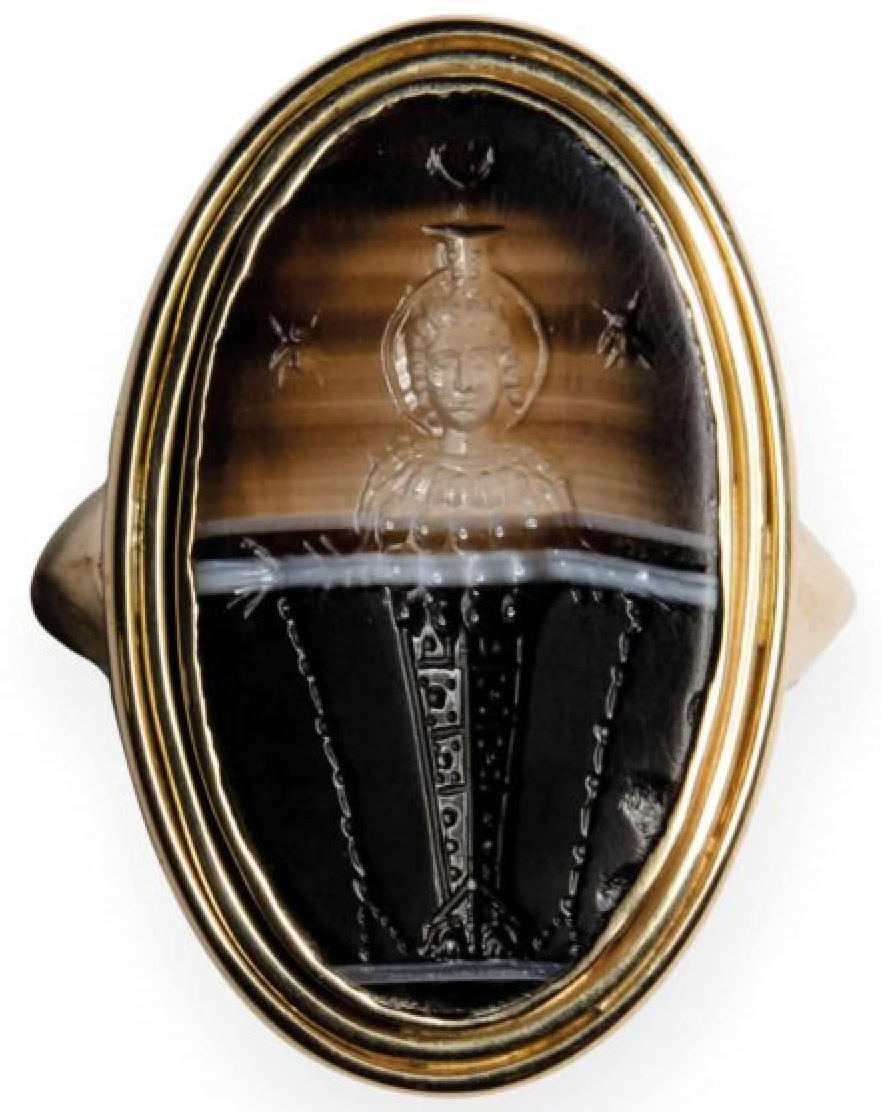
RING SET WITH A ROMAN INTAGLIA figuring ARTEMIS EPHESUS Roman art, XNUMXst BC. - XNUMXst century AD. J.-C. Intaglio on banded agate; 15 x 25 mm - 18K gold setting; 10,27 grams; TD_ 59 Origin French private collection A ROMAN BANDED AGATE INTAGLIO SET ON A MODERN GOLD RING. ARTEMIS OF EPHESUS. 1ST CENTURY BC - 1ST CENTURY AD 0,6 x 1 in; 10,27 grams. This representation is inspired by the cult of Artemis Ephesia, in relation to the sculptures that once reproduced the idol present in the temple of Artemis in Ephesus and considered at that time to be one of the seven wonders of the world. The goddess wears the chiton tight under an apron (sometimes decorated with animal protomes) and a belt; on the bust, numerous nipples: symbol of bulls scrotum offered in sacrifice to Artemis, in her role of goddess of fertility. A cylindrical crown (polos) and a disc adorn her head.This figure refers to the famous alabaster sculpture, from the roman imperial period, kept at the National Archaeological Museum in Naples (Farnese collection). On both sides of her face, a bee, and above, a crescent moon. The presence of a bee is found in greek coins associated with Ephesus. But the presence of two bees is rarer - only one other known specimen, an intaglio kept at the Staatliche Museum in Munchen1. The execution of this intaglio attests to the greatness of the engraver, who beyond the symbolic iconography of the goddess, brings a particular physiognomic to the face, which can almost be interpreted as the desire to represent a woman of high rank under the goddess features. Presence of globular elements. Signs of wear. This representation is inspired by the cult images of Artemis Ephesia, namely sculptures that once reproduced the idol present in the temple of Artemis in Ephesus and considered at the time, as one of the seven wonders of the world. The goddess wears the chiton tight under an apron (sometimes decorated with animal protomes) and a belt; on the bust are many nipples: symbol of the scrotum of bulls offered in sacrifice to Artemis, in her role as goddess of fertility. A cylindrical crown (polos) interpreted and a disc adorn his head. This figure refers to the famous alabaster sculpture, from the Roman imperial period, preserved in the National Archaeological Museum of Naples (Farnese collection). On either side of his face, a bee, flanking the idol, and above, a crescent moon. The presence of a bee is found in Greek coins associated with Ephesus. But the presence of two bees is rarer – only one other known specimen, that of a gem preserved in the Staatliche Munzsammlung, Munchen1. The execution of this intaglio attests to the great prowess of the engraver, who beyond the symbolic iconography of the goddess, brings a particular physiognomy to the face, can almost be interpreted as the desire to include a high-ranking woman in Artemis Ephesine. Presence of globular elements. Signs of wear.
Author: Roman | Date: 1ST CENTURY BC - 1ST CENTURY AD

